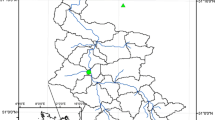Abstract
An artificial neural network (ANN) technology is presented as an alternative to physical-based modeling of subsurface water distribution from trickle emitters. Three options are explored to prepare input–output functional relations from a database created using a numerical model (HYDRUS-2D). From the database the feasibility and advantages of the three alternative options are evaluated: water-content at defined coordinates, moment analysis describing the shape of the plume, and coordinates of individual water-content contours. The best option is determined in a way by the application objectives, but results suggest that prediction using moment analyses is probably the most versatile and robust and gives an adequate picture of the subsurface distribution. Of the other two options, the direct determination of the individual water contours was subjectively judged to be more successful than predicting the water content at given coordinates, at least in terms of describing the subsurface distribution. The results can be used to estimate subsurface water distribution for essentially any soil properties, initial conditions or flow rates for trickle sources.
Similar content being viewed by others
References
Bresler E (1978) Analysis of trickle irrigation with application to design problems. Irrig Sci 1: 3–17. doi:10.1007/BF00269003
Lubana PPS, Narda NK (2001) Soil and water modeling: soil water dynamics under trickle emitters—a review. J Agric Eng Res 78: 217–232. doi:10.1006/jaer.2000.0650
Mmolawa K, Or D (2000) Water and solute dynamics under a drip-irrigated crop: experiments and analytical model. Trans ASAE 43: 1597–1608
Mmolawa K, Or D (2003) Experimental and numerical evaluation of analytical volume balance model for soil water dynamics under drip irrigation. Soil Sci Soc Am J 67: 1657–1671
Ben-Gal A, Lazarovitch N et al (2004) Subsurface drip irrigation in gravel-filled cavities. Vadose Zone J 3: 1407–1413
Skaggs TH, Trout T et al (2004) Comparison of HYDRUS-2D simulations of drip irrigation with experimental observations. J Irrig Drain Eng 130: 304–310. doi:10.1061/(ASCE)0733-9437(2004)130:4(304)
Green WH, Ampt GA (1911) Studies on soil physics. Part 1. The flow of air and water through soils. J Agric Sci 4: 1–24
Gardner WR (1958) Some steady state solutions of unsaturated moisture flow equations with application to evaporation from a water table. Soil Sci 85: 228–232
Warrick AW, Lazarovitch N (2007) Infiltration from a strip source. Water Resour Res 43: W03420. doi:10.1029/2006WR004975
Mansell RS, Ma L et al (2002) Adaptive grid refinement in numerical models for water flow and chemical transport in soil: a review. Vadose Zone J 1: 222–238
Schaap MG, Bouten W (1996) Modeling water retention curves of sandy soils using neural networks. Water Resour Res 32: 3033–3040. doi:10.1029/96WR02278
Schaap MG, Leij FJ et al (1998) Neural network analysis for hierarchical prediction of soil hydraulic properties. Soil Sci Soc Am J 62: 847–855
Minasny B, McBratney AB (2002) The neuro-m method for fitting neural network parametric pedotransfer functions. Soil Sci Soc Am J 66: 352–361
Minasny B, Hopmans JW et al (2004) Neural networks prediction of soil hydraulic functions from multi-step outflow data. Soil Sci Soc Am J 68: 417–429
Schaap MG, Leij FJ et al (2001) ROSETTA: a computer program for estimating soil hydraulic parameters with hierarchical pedotransfer functions. J Hydrol (Amst) 251: 163–176. doi:10.1016/S0022-1694(01)00466-8
Schmitz GH, Schutze N et al (2002) New strategy for optimizing water application under drip irrigation. J Irrig Drain Eng 128: 287–297. doi:10.1061/(ASCE)0733-9437(2002)128:5(287)
Jiusheng L, Yoder RE et al (2004) Simulation of nitrate distribution under drip irrigation using artificial neural networks. Irrig Sci 23: 29–37. doi:10.1007/s00271-003-0090-6
Richards LA (1931) Capillary conduction of liquids in porous mediums. Physics 1: 318–333. doi:10.1063/1.1745010
Šimůnek J, Sejna M et al (1999) The HYDRUS-2D software package for simulating the two-dimensional movement of water, heat, and multiple solutes in variably-saturated media, version 2.0. US Salinity Laboratory, Riverside, CA
Lazarovitch N, Šimůnek J et al (2005) System-dependent boundary condition for water flow from subsurface source. Soil Sci Soc Am J 69: 46–50
Gardenas AI, Hopmans JW et al (2005) Two-dimensional modeling of nitrate leaching for various fertigation scenarios under micro-irrigation. Agric Water Manag 74: 21–242. doi:10.1016/j.agat.2004.11.011
Lazarovitch N, Warrick AW et al (2007) Water content distribution in drip irrigation described by moment analyses. Vadose Zone J 6: 116–123. doi:10.2136/vzj2006.0052
Mualem Y (1976) A new model for predicting the hydraulic conductivity of unsaturated porous media. Water Resour Res 12: 513–522. doi:10.1029/WR012i003p00513
van Genuchten MT (1980) A closed-form equation for predicting the hydraulic conductivity of unsaturated soils. Soil Sci Soc Am J 44: 892–898
Carsel RF, Parrish RS (1988) Developing joint probability distributions of soil water retention characteristics. Water Resour Res 24: 755–769. doi:10.1029/WR024i005p00755
Poulton M (ed) (2001) Computational neural networks for geophysical data processing. Pergamon, Amsterdam
Hertz J, Krogh A et al (1991) Introduction to the theory of neural computation. Addison Wesley, New York
Bishop C (1995) Neural networks for pattern recognition. Oxford Press, London
StatSoft (2001) STATISTICA for Windows v. 6.0. StatSoft, Tulsa, OK
Author information
Authors and Affiliations
Corresponding author
Rights and permissions
About this article
Cite this article
Lazarovitch, N., Poulton, M., Furman, A. et al. Water distribution under trickle irrigation predicted using artificial neural networks. J Eng Math 64, 207–218 (2009). https://doi.org/10.1007/s10665-009-9282-2
Received:
Accepted:
Published:
Issue Date:
DOI: https://doi.org/10.1007/s10665-009-9282-2




